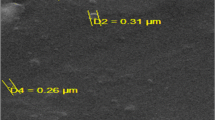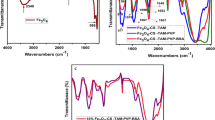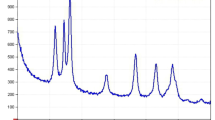Abstract
The copper oxide nanoparticles (CuO NPs) were synthesized by a simple method and then coated with the bovine serum albumin (BSA) to form CuO@BSA NPs. Finally, curcumin (CUR) as an anticancer drug was loaded to the CuO@BSA NPs. The characterization of nanoparticles was carried out by Fourier-transport infrared (FT-IR), ultraviolet-visible (UV-vis), transmission electron microscopy (TEM), and atomic force microscopy (AFM) analysis. It was found that the synthesized CuO@BSA-CUR nanoparticles were spherical with a particle size of 20–30 nm. Also, the result of drug release in the biological environment showed that maximum drug release for this nanocarrier in pH of 7.4 was measured 72% after 48 h. The cytotoxicity of CuO@BSA-CUR against the MDA-MB-231 breast cancer cell line was studied by MTT assay test. The results indicated that CuO@BSA-CUR nanoparticles have a remarkable anticancer effect on breast cancer cell line.






Similar content being viewed by others
References
Bertram JS (2000) The molecular biology of cancer. Molecular aspects of medicine 21(6):167–223. https://doi.org/10.1016/C2013-0-07228-3
Schreiner L (2013) Innovative cancer therapeutics based on polymers or biogenic drugs evaluated in murine tumor models. Dissertation, LMU München. Diss. Lmu, Thesis. https://doi.org/10.5282/edoc.15618
Rahib L et al (2014) Projecting cancer incidence and deaths to 2030: the unexpected burden of thyroid, liver, and pancreas cancers in the United States. Cancer Res 74(11):2913–2921
Malam Y, Loizidou M, Seifalian AM (2009) Liposomes and nanoparticles: nanosized vehicles for drug delivery in cancer. Trends Pharmacol Sci 30(11):592–599
Xu T, Zhang N, Nichols HL, Shi D (2007) Modification of nanostructured materials for biomedical applications. Mater Sci Engineering: C 27(3):579–594
Park JW (2002) Liposome-based drug delivery in breast cancer treatment. Breast Cancer Res 4(3):95
Chen F-H, Zhang L-M, Chen Q-T et al (2010) Synthesis of a novel magnetic drug delivery system composed of doxorubicin conjugated Fe 3 O 4 nanoparticle cores and a PEG-functionalized porous silica shell. Chem Commun 46(45):8633–8635
Dobson J (2006) Magnetic nanoparticles for drug delivery. Drug Dev Res 67(1):55–60
Karami E, Behdani M, Kazemi-Lomedasht F (2019) Albumin nanoparticles as nanocarriers for drug delivery: Focusing on antibody and nanobody delivery and albumin-based drugs. Journal of Drug Delivery Science and Technology 55:101471
Jo Y-K et al (2017) Enhancement of the antitumor effect of methotrexate on colorectal cancer cells via lactate calcium salt targeting methionine metabolism. Nutr Cancer 69(4):663–673
Chen G et al (2016) Nanochemistry and nanomedicine for nanoparticle-based diagnostics and therapy. Chem Rev 116(5):2826–2885
Wang H et al (2002) Preparation of CuO nanoparticles by microwave irradiation. J Cryst Growth 244(1):88–94
Kose S et al (2012) Some physical properties of In doped copper oxide films produced by ultrasonic spray pyrolysis. Curr Appl Phys 12(3):890–895
Applerot G et al (2012) Understanding the antibacterial mechanism of CuO nanoparticles: revealing the route of induced oxidative stress. Small 8(21):3326–3337
Grigore M, Elena et al (2016) Methods of Synthesis, Properties and Biomedical Applications of CuO Nanoparticles. Pharmaceuticals 9:75
Nishino F et al (2017) Formation of CuO nano-flowered surfaces via submerged photo-synthesis of crystallites and their antimicrobial activity. Sci Rep 7:1–11
Wang J, Zhang B (2018) Bovine serum albumin as a versatile platform for cancer imaging and therapy. Curr Med Chem 25(25):2938–2953
Kratz F (2008) Albumin as a drug carrier: design of prodrugs, drug conjugates and nanoparticles. J Controlled Release 132(3):171–183
Ranucci E et al (1995) Modification of albumins by grafting poly (amido amine) chains. Polymer 36:2989–2994
Wongsasulak S et al (2007) The effect of solution properties on the morphology of ultrafine electrospun egg albumen–PEO composite fibers. Polymer 48(2):448–457
Jahanban-Esfahlan A, Roufegarinejad L, Jahanban-Esfahlan R, Tabibiazar M, Amarowicz R(2020) Latest developments in the detection and separation of bovine serum albumin using molecularly imprinted polymers. Talanta 207:120317
Wilken. R R, Veena. MS, Wang MB, Srivatsan ES (2011) Curcumin: a review of anti-cancer properties and therapeutic activity in head and neck squamous cell carcinoma. Mol Canc 10(1):12
Ahmed M et al (2018) Sulfonamides containing curcumin scaffold: Synthesis, characterization, carbonic anhydrase inhibition and molecular docking studies. Bioorg Chem 76:218–227
Jagetia G.C (2007) Radioprotection and radiosensitization by curcumin. Adv Exp Med Biol 595:301–320
**e J et al (2017) Therapeutic nanoparticles based on curcumin and bamboo charcoal nanoparticles for chemo-photothermal synergistic treatment of cancer and radioprotection of normal cells. ACS Appl Mater Interfaces 9(16):14281–14291
Sadhukha T, Scott Wiedmann T, Panayam J (2014) Enhancing Therapeutic Efficacy through Designed Aggregation of Nanoparticles. Biomaterials 35(27):7860–7869
Acknowledgements
The work presented here is the result of the Master’s thesis of Tahmineh Atloo with No. 33131 from the University of Zanjan. The authors would like to thank various people for their contribution to this work, their valuable technical support on this work, and their help in the collection of plant data, and also all the technicians who helped in handling the instruments. Also, the authors gratefully acknowledge Zanjan University of Medical Sciences for this research work.
Author information
Authors and Affiliations
Corresponding authors
Additional information
Publisher’s Note
Springer Nature remains neutral with regard to jurisdictional claims in published maps and institutional affiliations.
Rights and permissions
About this article
Cite this article
Atloo, T., Mohammadkhani, R., Mohammadi, A. et al. The Bovine Serum Albumin Coated Copper Oxide Nanoparticle for Curcumin Delivery in Biological Environment: In-vitro Drug Release. J Polym Environ 30, 3203–3208 (2022). https://doi.org/10.1007/s10924-022-02401-9
Accepted:
Published:
Issue Date:
DOI: https://doi.org/10.1007/s10924-022-02401-9




